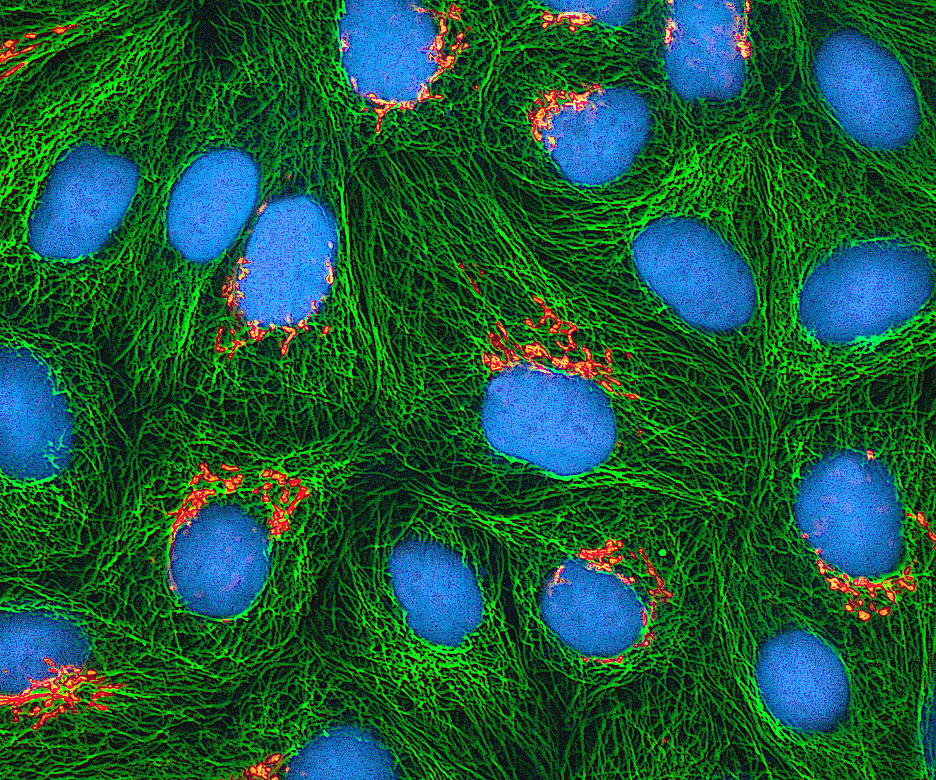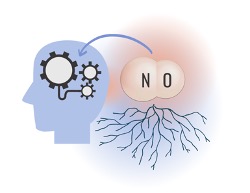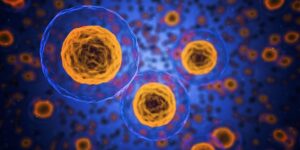
Figure: A fluorescent protein is expressed in human epithelial cells of the Henrietta Lacks (HeLa) strain. Scientists have long used reporter genes coding for fluorescent proteins to visualize the expression of genes of interest. Now, the development of acoustic reporter genes allows the same sort of local visualization to be achieved by sound. (Source: Wikimedia Commons, NIH)
Reporter genes are nothing new. These DNA segments are inserted into an organism’s genome adjacent to a gene of interest in order to monitor the expression of that gene. If the gene of interest is expressed, the reporter gene will be as well. In the past, evidence of expression of the reporter gene has commonly taken the form of fluorescent proteins that show up under certain lighting, but it can be difficult to see all the expressed proteins in cells multiple layers deep in tissue. Reporter visibility is limited by the ability of light to penetrate into living tissues, as well as the limited fluorescent intensity of the reporters themselves (California Institute of Technology, 2021).
Rather than working with traditional reporter genes coding for fluorescent or luminescent proteins, Sawyer et al. (2021) developed acoustic reporter genes. These new genes code for gas vesicles—hollow protein structures that audibly resonate when they come into contact with ultrasound waves. This helps address the fluorescent protein problem of depth, as ultrasound waves can penetrate deep tissue. This is true because waves with smaller wavelengths tend to be more easily reflected or refracted in outer tissues, but ultrasound waves with longer wavelengths are able to achieve better tissue penetration (California Institute of Technology, 2021).
Remarkably, the acoustic signal emitted by gas vesicles struck with ultrasound enables researchers to pinpoint single cells within an organism. This is thanks to an even newer technique using acoustic reporter genes. In this novel method of analysis, instead of using ultrasound waves to simply trigger an acoustic response, stronger ultrasound waves are used to rupture the gas vesicles. The process results in a briefer but more intense acoustic signal similar to the popping sound that might emanate from a punctured balloon. The difference between the original acoustic signals issued by the gas vesicles and the signals emitted by the ruptured vesicles offers a 1000-fold increase in sensitivity, making detection far easier. No damaging effects to mammalian cells have been found to result from the rupture of gas vesicles, and resulting damage to single bacterial cells is not frequent enough to result in significant damage to the bacterial population as a whole (California Institute of Technology, 2021). The rupturing method is so exact that it allows researchers to track bacterial cells subjected to acoustic reporters in real time as the mouse liver uptakes bacteria that were injected into the tail vein (Sawyer et al., 2021).
Because acoustic reporter genes are still a new technology, the range of their practical applications largely remains to be seen. Sawyer et al. (2021) expect acoustic reporter genes to be valuable in noninvasive imaging of cell functions. Single-cell imaging with acoustic reporter genes might even shed (non-fluorescent) light on the makeup of the gut microbiome (California Institute of Technology, 2021). The general utility of ultrasound in imaging is further demonstrated by the recent rise in photoacoustic technology, which uses light energy to trigger thermoelastic expansion in tissues of interest, ultimately causing these tissues to produce ultrasound waves that are processed to create an image of tissue absorption contrast. Photoacoustic nanoparticles have successfully been used to image human embryonic stem cell-derived cardiomyocytes in living mouse hearts (Qin et al., 2018). As acoustic reporter genes join the ranks of such ultrasound-based imaging techniques, studies will likely continue to refine the method used by Sawyer et al. (2021), possibly by modifying the gas vesicles to make them more easily poppable. Ultimately, acoustic reporter genes have potential to facilitate more precise examinations of gene expression, and researchers are all ears.
References
California Institute of Technology. (2021, August 6). ‘Seeing’ single cells with sound. Phys.org. https://phys.org/news/2021-08-cells.html
Qin, X., Chen, H., Yang, H., Wu, H., Zhao, X., Wang, H., Chour, T., Neofytou, E., Ding, D., Daldrup-Link, H., Heilshorn, S. C., Li, K., & Wu, J. C. (2018). Photoacoustic imaging of embryonic stem cell-derived cardiomyocytes in living hearts with ultrasensitive semiconducting polymer nanoparticles. Advanced Functional Materials, 28(1), 1704939. https://doi.org/10.1002/adfm.201704939
Sawyer, D. P., Bar-Zion, A., Farhadi, A., Shivaei, S., Ling, B., Lee-Gosselin, A., & Shapiro, M. G. (2021). Ultrasensitive ultrasound imaging of gene expression with signal unmixing. Nature Methods, 18(8), 945–952. https://doi.org/10.1038/s41592-021-01229-w
Related Posts
Dancing Neurons & Their Exciting Impacts
Figure 1: A network of neurons in the brain Source: Elizabeth...
Read MorePrescribing Ecotherapy: A Powerful Health Intervention
This publication is in proud partnership with Project UNITY’s Catalyst Academy 2023...
Read MoreNeuroscience, Narrative, and Never-Ending Stories
Figure 1: A field of poppies. The myths of Persephone...
Read MoreThere’s NO Telling What Nitric Oxide Might Bring to Alzheimer’s Disease Research
Figure 1: As Alzheimer’s disease research begins to shift away...
Read MoreMind Missing Out? Fear of Missing Out and the Brain
Figure: A person scrolling through news articles on their smartphone....
Read MoreCellChat Enables Biologists to Understand Cellular Communication
Figure 1: CellChat, an open-source R package, provides researchers with...
Read MoreCaroline Conway






